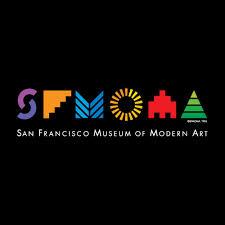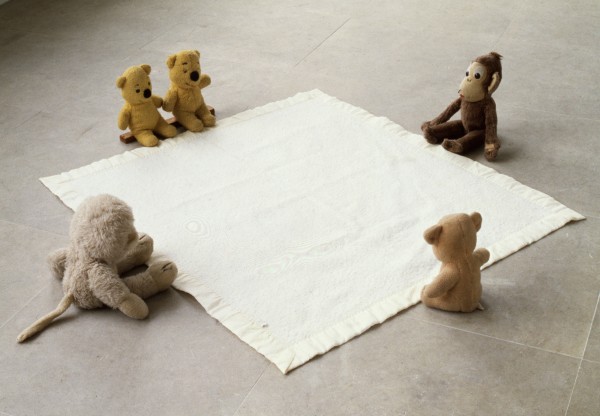Defining Art: Pranks at the San Francisco Museum of Modern Art

Never underestimate the power of the puncturing prank. It acts as subversion, and before you know it, that April Fool’s joke becomes the order of the day, the next gospel, the affirmed orthodoxy. Consider, for instance, a pair of glasses left on the floor of the San Francisco Museum of Modern Art.
On May 23 both Kevin Nguyen and T. J. Khayatan from San Jose decided to do what has, in fact, been done before: place an object on the floor of a museum, preferably under some caption, and observe the process of conversion. As Khayatan explained, “some of the ‘art’ wasn’t very surprising to some of us. We stumbled upon a stuffed animal on a grey blanket and questioned if this was really impressive to some of the nearby people.”[1]
That particular work referenced by Khayatan had the name of Arenas, a creation of Mike Kelley who explained how he liked creating “art about the commodity in terms of a classical notion of perfection.”[2]
Go back to Marcel Duchamp’s Fountain (1917) and we have the first noted attempt to mock what can only be a form of “artification” (dare one even use that term?), where a utilitarian piece of high functionality becomes an expression of artistic sentiment. It consisted of Duchamp’s selection of a Bedfordshire model porcelain urinal which received, on its return to his studio, the signature of “R. MUTT 1917.” Having been witnessed by a few, it promptly vanished, leaving replicas in their place.
The conservative view on this – and here, art critic Brian Sewell is roaring from beyond the grave – is that this is pure bollocks, an act of clever subversion, ironic and pure prank. The other side of it come the establishment paladins and sponsors, shielded by coy art critics who do not wish to be offensive, and proceed to call everything art with verbiage in heavy dress.
Martin Grayford, writing about Fountain in February 2008 ahead of the Tate Modern exhibition “Duchamp, Man Ray, Picabia”, did precisely that, suggesting that the urinal was “a rather beautiful object in its own right and a blindingly brilliant logical move, check-mating all conventional ideas about art. But it was also a highly successful practical joke.”[3]
The 2002 engagement between Sewell and Matthew Collings, his much junior counterpart in Prospect, serves a few instructive purposes here. The point of debate was simple enough: “Are young British artists nincompoops and frauds?”[4]
Collings simply takes such conceptual art, products of “modernism and post-modernism” as “self-referential. There is no point crying about it; this is the art that society produces.” Rather than engaging the idea of art, Collings simply accepts the totality of the premise that all can be art. He merely wishes to point out that there is a “structure and a system” which enables you to see meaning in it.
Sewell’s tart demolition was entirely pertinent. Collings was playing grand court fool and fence sitter, not wishing to alienate those who paid for his reviews. “That art itself is either a structure or a system in any deliberate or even art historical sense, is to me an incomprehensible notion”.
When one is in the puffery of avoiding offence against the big wigs of the art world (or other worlds, for that matter), being struck off the invitation list hangs as a continual threat. The dinner parties dry up; the canapé rounds vanish. Lonely, such a critic can only rely on brute revelation, becoming a loud and disagreeable Doubting Thomas.
For the two San Jose teens, the Duchamp effect kicked in almost immediately, not least of all from SFMOMA itself. Rather than blushing with disgrace, the museum staff decided to inflate Cruda’s ego by extolling the lessons of history. “Do we have a Marcel Duchamp in our midst?”[5]
One remark dredged up from Facebook’s endless corridors of digital piffle came up with the view that “by placing his glasses there and inspiring people to look at them in a new light, and by what he was trying to convey by doing so, this guy did, in fact, create a work of modern art! Sweet!” The network NBC, covering the Bay Area, decided to tweet that, “Everyone can make their own art.”[6]
Jack Moore, writing for GQ, demonstrated a similar obliviousness of definitions and art terms by seeing behavioural intent as somehow artistic. Forget the nature of the object – search for the deep, bottom hugging meaning. “I think there’s a good argument to be made that it is actually art commenting on the opaque and sometimes seemingly slapdash nature of some modern art.”[7]
Such imbecility has a tendency to be all consuming. Rather than dealing with the question of art itself, it avoids it altogether. “Let’s remember,” insists an art writer for theHuffington Post, “Museums aren’t out to trick anyone. They’re simply a space where looking, and more importantly, slow, thoughtful seeing, is encouraged.”[8]
The paid-up fence sitter comes to the fore in such exculpatory drivel, assuming that the prank itself is art, a way of being contemplative about the sanctioned faecal matter. This confuses the act of debunking criticism with what art, the subject of that criticism, actually is. Hardly reassuring for modern critics. One can very well agree with Moore that this was a “good prank” – but it hardly qualifies as art.
Dr. Binoy Kampmark was a Commonwealth Scholar at Selwyn College, Cambridge. He lectures at RMIT University, Melbourne. Email: [email protected]
Notes
[2] http://bombmagazine.org/
[4] http://www.prospectmagazine.
[5] https://twitter.com/SFMOMA/
[7] http://www.gq.com/story/


